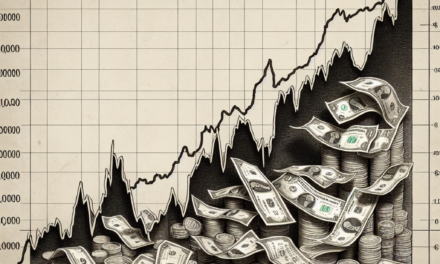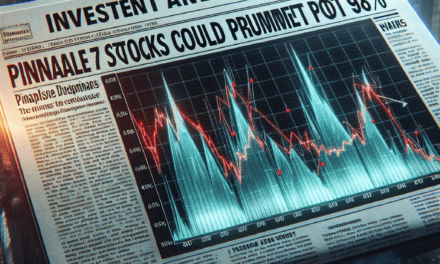“Investors Stand Firm: Commitment to Nvidia, Tesla, and Key Bitcoin Players Soars, Says Schwab.”
Introduction
Investors continue to show strong commitment to key players in the technology and cryptocurrency sectors, particularly Nvidia, Tesla, and significant Bitcoin stakeholders, as highlighted in a recent report by Schwab. This enduring interest reflects confidence in the growth potential and innovation capabilities of these companies, which are at the forefront of their respective industries. Nvidia’s advancements in artificial intelligence and graphics processing, Tesla’s leadership in electric vehicles and sustainable energy, and the strategic positioning of major Bitcoin investors underscore a broader trend of optimism in the market, despite ongoing economic uncertainties.
Investor Confidence in Nvidia’s Future Growth
Investor confidence in Nvidia’s future growth remains robust, as evidenced by recent analyses from financial institutions such as Charles Schwab. Nvidia, a leader in graphics processing units (GPUs) and artificial intelligence (AI) technology, has consistently demonstrated its ability to innovate and adapt to the rapidly evolving tech landscape. This adaptability is particularly significant in an era where AI and machine learning are becoming integral to various industries, from healthcare to automotive. As a result, investors are increasingly viewing Nvidia not merely as a semiconductor company but as a pivotal player in the broader tech ecosystem.
The company’s strategic investments in AI and data centers have positioned it favorably for sustained growth. Nvidia’s GPUs are essential for training AI models, and as demand for AI applications surges, so too does the need for high-performance computing solutions. This trend has not gone unnoticed by investors, who are keenly aware of the potential for Nvidia to capitalize on the burgeoning AI market. Furthermore, Nvidia’s recent partnerships with major tech firms and cloud service providers underscore its commitment to remaining at the forefront of technological advancements. These collaborations not only enhance Nvidia’s product offerings but also solidify its reputation as a trusted partner in the tech industry.
Moreover, Nvidia’s financial performance has been impressive, with significant revenue growth reported in recent quarters. This growth can be attributed to the increasing adoption of GPUs in gaming, data centers, and AI applications. Investors are encouraged by these results, as they reflect the company’s ability to generate substantial returns in a competitive market. Additionally, Nvidia’s proactive approach to research and development ensures that it remains ahead of its competitors, further bolstering investor confidence.
Transitioning from Nvidia’s technological prowess, it is essential to consider the broader implications of its growth on the investment landscape. As Nvidia continues to expand its market share, it not only enhances its own prospects but also contributes to the overall health of the tech sector. This interconnectedness is vital, as a thriving tech industry can lead to increased investment opportunities across various sectors. Investors are increasingly recognizing that companies like Nvidia can serve as bellwethers for the market, influencing trends and shaping investor sentiment.
In light of these factors, it is clear that investor confidence in Nvidia is not merely a fleeting sentiment but rather a reflection of a well-founded belief in the company’s long-term potential. As the demand for AI and advanced computing solutions continues to rise, Nvidia is well-positioned to benefit from this trend. The company’s commitment to innovation, coupled with its strong financial performance, creates a compelling narrative for investors seeking growth opportunities in the tech sector.
In conclusion, the unwavering confidence that investors have in Nvidia’s future growth is indicative of a broader trend within the technology industry. As Nvidia continues to lead in AI and GPU technology, it not only reinforces its own market position but also inspires confidence in the tech sector as a whole. This dynamic interplay between innovation and investor sentiment highlights the importance of staying attuned to market developments, as companies like Nvidia pave the way for future advancements. Ultimately, the commitment of investors to Nvidia reflects a strategic understanding of the potential rewards that lie ahead in an increasingly digital and AI-driven world.
Tesla’s Market Resilience Amid Economic Uncertainty
In the current economic landscape, characterized by fluctuating market conditions and rising inflation, Tesla has demonstrated remarkable resilience, capturing the attention of investors and analysts alike. This resilience is particularly noteworthy given the broader challenges faced by the automotive industry and the technology sector. As consumers grapple with increased costs and shifting priorities, Tesla’s ability to maintain its market position speaks volumes about its strategic initiatives and brand loyalty.
One of the key factors contributing to Tesla’s market resilience is its unwavering commitment to innovation. The company has consistently pushed the boundaries of electric vehicle (EV) technology, introducing advancements that not only enhance performance but also improve safety and sustainability. For instance, Tesla’s ongoing development of battery technology has positioned it as a leader in energy efficiency, allowing the company to offer vehicles with longer ranges and faster charging times. This focus on innovation not only attracts environmentally conscious consumers but also reassures investors about the company’s long-term viability in a competitive market.
Moreover, Tesla’s robust supply chain management has played a crucial role in its ability to navigate economic uncertainties. While many automakers have struggled with supply chain disruptions, Tesla has adeptly managed its resources, ensuring that production remains steady. By securing long-term contracts with suppliers and investing in its own manufacturing capabilities, Tesla has mitigated some of the risks associated with global supply chain vulnerabilities. This proactive approach has not only bolstered production rates but has also instilled confidence among investors, who view the company’s operational efficiency as a significant asset.
In addition to its operational strengths, Tesla’s brand loyalty cannot be overlooked. The company has cultivated a dedicated customer base that is often willing to pay a premium for its vehicles. This loyalty is rooted in Tesla’s reputation for quality and performance, as well as its commitment to sustainability. As consumers increasingly prioritize eco-friendly options, Tesla’s position as a pioneer in the EV market has solidified its appeal. This strong brand identity not only drives sales but also enhances investor confidence, as a loyal customer base can provide a buffer against economic downturns.
Furthermore, Tesla’s strategic expansion into international markets has contributed to its resilience. By establishing a presence in key regions such as Europe and Asia, Tesla has diversified its revenue streams and reduced its dependence on any single market. This global approach not only mitigates risks associated with regional economic fluctuations but also positions Tesla to capitalize on the growing demand for electric vehicles worldwide. As governments implement stricter emissions regulations and consumers increasingly seek sustainable transportation options, Tesla’s international footprint is likely to yield significant returns.
In conclusion, Tesla’s market resilience amid economic uncertainty can be attributed to a combination of innovation, effective supply chain management, strong brand loyalty, and strategic global expansion. As investors continue to monitor the company’s performance, it is clear that Tesla’s ability to adapt and thrive in a challenging environment sets it apart from its competitors. With a steadfast commitment to advancing electric vehicle technology and a clear vision for the future, Tesla remains a compelling investment opportunity, reinforcing the confidence of stakeholders in its long-term growth potential. As the landscape evolves, Tesla’s strategic initiatives will likely play a pivotal role in shaping its trajectory and sustaining its market leadership.
The Role of Major Bitcoin Stakeholders in Market Stability
In the ever-evolving landscape of cryptocurrency, the role of major Bitcoin stakeholders has emerged as a pivotal factor in ensuring market stability. As the digital currency continues to gain traction among institutional and retail investors alike, the influence of these stakeholders cannot be overstated. According to recent insights from Schwab, the commitment of investors to companies like Nvidia and Tesla, alongside significant Bitcoin holders, underscores a broader trend of confidence in the cryptocurrency market. This confidence is particularly relevant in an environment characterized by volatility and uncertainty.
Major Bitcoin stakeholders, often referred to as “whales,” possess substantial amounts of Bitcoin, which grants them considerable influence over market dynamics. Their trading activities can lead to significant price fluctuations, making their behavior a focal point for market analysts and investors. When these stakeholders choose to hold onto their assets rather than sell, it can create a sense of stability in the market. This phenomenon is particularly important during periods of heightened volatility, as it can mitigate the impact of sudden sell-offs that might otherwise destabilize prices.
Moreover, the actions of these major stakeholders often serve as a barometer for market sentiment. When large holders accumulate more Bitcoin, it typically signals confidence in the asset’s long-term value. Conversely, significant sell-offs by these stakeholders can trigger panic among smaller investors, leading to a cascade of selling that exacerbates market downturns. Therefore, the behavior of major Bitcoin holders is closely monitored by market participants, as it can provide valuable insights into the overall health of the cryptocurrency ecosystem.
In addition to their influence on price stability, major Bitcoin stakeholders also play a crucial role in fostering institutional interest in the cryptocurrency market. As more institutional investors enter the space, the presence of these large holders can lend credibility to Bitcoin as a legitimate asset class. This is particularly relevant in light of the increasing acceptance of Bitcoin by traditional financial institutions and corporations. The involvement of major stakeholders can help to bridge the gap between the traditional financial world and the burgeoning cryptocurrency market, facilitating a smoother integration of digital assets into mainstream finance.
Furthermore, the commitment of investors to companies like Nvidia and Tesla, which are heavily involved in the cryptocurrency space through mining and technological advancements, reflects a broader recognition of the interconnectedness between traditional tech sectors and the digital currency market. As these companies continue to innovate and expand their offerings, they contribute to the overall infrastructure that supports Bitcoin and other cryptocurrencies. This symbiotic relationship enhances market stability, as advancements in technology can lead to improved security, scalability, and accessibility for all participants.
In conclusion, the role of major Bitcoin stakeholders in market stability is multifaceted and significant. Their influence extends beyond mere price movements; it encompasses the broader dynamics of market sentiment and institutional adoption. As investors remain committed to key players like Nvidia and Tesla, the interconnectedness of these entities with major Bitcoin holders becomes increasingly apparent. This relationship not only fosters confidence in the cryptocurrency market but also paves the way for a more stable and resilient financial ecosystem. As the landscape continues to evolve, the actions and decisions of these stakeholders will undoubtedly remain a focal point for investors seeking to navigate the complexities of the digital currency market.
Schwab’s Insights on Long-Term Investment Strategies
In the ever-evolving landscape of investment opportunities, Schwab’s insights shed light on the enduring commitment of investors to key players such as Nvidia, Tesla, and significant stakeholders in the Bitcoin market. This commitment is not merely a reflection of current market trends but rather an indication of a broader, long-term investment strategy that prioritizes innovation and growth potential. As technology continues to reshape industries, companies like Nvidia and Tesla stand at the forefront, driving advancements that capture the attention of both institutional and retail investors alike.
Nvidia, renowned for its cutting-edge graphics processing units (GPUs), has established itself as a leader in artificial intelligence and machine learning. The company’s strategic positioning within these burgeoning fields has made it a focal point for investors seeking exposure to the future of technology. Schwab’s analysis highlights that investors are increasingly recognizing the potential of Nvidia’s products to revolutionize various sectors, from gaming to data centers and autonomous vehicles. This recognition is not fleeting; rather, it reflects a calculated belief in Nvidia’s ability to sustain its competitive edge and deliver long-term value.
Similarly, Tesla’s influence in the automotive industry cannot be overstated. As a pioneer in electric vehicles, Tesla has not only transformed consumer perceptions of sustainable transportation but has also set a benchmark for innovation in the sector. Schwab notes that investors are drawn to Tesla not only for its impressive sales figures but also for its commitment to expanding its product line and enhancing its technological capabilities. The company’s ambitious plans for energy solutions and autonomous driving further solidify its position as a long-term investment opportunity. Investors are increasingly viewing Tesla as more than just an automaker; they see it as a comprehensive energy and technology company poised for sustained growth.
In addition to these technology giants, the cryptocurrency market, particularly Bitcoin, has garnered significant attention from investors. Schwab’s insights reveal that major stakeholders in Bitcoin are being viewed as integral components of a diversified investment portfolio. The volatility of cryptocurrencies may deter some investors, yet those with a long-term perspective recognize the potential for substantial returns. Bitcoin’s status as a digital asset and its growing acceptance among institutional investors have contributed to its appeal. Schwab emphasizes that investors are not merely speculating on short-term price movements; instead, they are strategically positioning themselves to benefit from the potential maturation of the cryptocurrency market.
Moreover, the commitment to these investments reflects a broader trend among investors who are increasingly prioritizing companies that demonstrate resilience and adaptability in the face of market fluctuations. Schwab’s analysis suggests that a long-term investment strategy should encompass a thorough understanding of the underlying technologies and market dynamics that drive these companies. By focusing on innovation and growth potential, investors can navigate the complexities of the market with greater confidence.
In conclusion, Schwab’s insights into the commitment of investors to Nvidia, Tesla, and major Bitcoin stakeholders underscore the importance of a long-term investment strategy. As these companies continue to lead in their respective fields, investors are recognizing the value of aligning their portfolios with entities that are not only shaping the future but also demonstrating the capacity for sustained growth. This strategic approach allows investors to weather market volatility while positioning themselves for potential long-term gains, ultimately reinforcing the notion that informed, forward-thinking investment decisions can yield significant rewards.
Analyzing Nvidia’s Competitive Edge in AI Technology
As the landscape of artificial intelligence (AI) technology continues to evolve, Nvidia has emerged as a formidable player, capturing the attention of investors and industry experts alike. The company’s competitive edge in AI technology is underscored by its innovative approach to graphics processing units (GPUs), which have become essential for AI applications. Nvidia’s GPUs are not only powerful but also optimized for parallel processing, making them particularly well-suited for the complex computations required in machine learning and deep learning. This capability allows Nvidia to maintain a significant lead over its competitors, as the demand for high-performance computing continues to surge.
Moreover, Nvidia’s strategic investments in research and development have further solidified its position in the AI sector. By continuously enhancing its hardware and software offerings, the company has been able to cater to a diverse range of industries, from healthcare to automotive. For instance, Nvidia’s GPUs are utilized in medical imaging, enabling faster and more accurate diagnoses, while its technology powers autonomous vehicles, facilitating safer and more efficient transportation. This versatility not only broadens Nvidia’s market reach but also reinforces its reputation as a leader in AI technology.
In addition to its robust product lineup, Nvidia has cultivated a strong ecosystem that supports developers and researchers. The introduction of platforms such as CUDA, which allows developers to leverage the power of Nvidia GPUs for parallel computing, has fostered a vibrant community of innovators. This ecosystem is further enhanced by partnerships with leading tech companies and academic institutions, which facilitate the exchange of ideas and accelerate advancements in AI research. As a result, Nvidia is not merely a hardware provider; it has positioned itself as a key enabler of AI innovation.
Transitioning from its technological prowess, Nvidia’s financial performance also reflects its competitive advantage in the AI space. The company’s revenue growth has been remarkable, driven by the increasing adoption of AI across various sectors. Investors have taken note of this trend, recognizing that Nvidia’s strong financials are indicative of its ability to capitalize on the burgeoning demand for AI solutions. This financial stability allows Nvidia to reinvest in its technology and expand its market presence, creating a virtuous cycle that further enhances its competitive edge.
Furthermore, the global shift towards AI-driven solutions has prompted Nvidia to explore new markets and applications. The company’s foray into AI-driven data centers and cloud computing services exemplifies its commitment to staying ahead of the curve. By providing scalable and efficient solutions for businesses looking to harness the power of AI, Nvidia is not only diversifying its revenue streams but also reinforcing its status as a leader in the industry. This proactive approach to market expansion is crucial in an environment where technological advancements occur at a rapid pace.
In conclusion, Nvidia’s competitive edge in AI technology is a result of its innovative hardware, strategic investments in research and development, and a robust ecosystem that supports collaboration and innovation. Coupled with strong financial performance and a commitment to exploring new markets, Nvidia is well-positioned to maintain its leadership in the AI sector. As investors remain committed to the company, it is clear that Nvidia’s influence on the future of AI technology will continue to grow, shaping the way industries operate and innovate in the years to come.
Tesla’s Innovations and Their Impact on Investor Sentiment
Tesla has consistently positioned itself at the forefront of innovation within the automotive and energy sectors, and this commitment to groundbreaking technology has significantly influenced investor sentiment. As the company continues to unveil advancements in electric vehicle (EV) technology, autonomous driving capabilities, and energy solutions, investors remain optimistic about its long-term growth potential. This optimism is not merely a reflection of Tesla’s current market performance but is deeply rooted in the company’s strategic vision and its ability to disrupt traditional industries.
One of the most notable innovations from Tesla is its development of advanced battery technology. The introduction of the 4680 battery cell, which promises to enhance energy density while reducing costs, has garnered considerable attention. This innovation is expected to not only improve the performance of Tesla’s vehicles but also to lower production costs, thereby increasing profit margins. Investors are keenly aware that advancements in battery technology are critical for the broader adoption of electric vehicles, and Tesla’s leadership in this area reinforces their confidence in the company’s future.
Moreover, Tesla’s strides in autonomous driving technology have further solidified its position as a leader in the EV market. The rollout of Full Self-Driving (FSD) capabilities has been met with both excitement and scrutiny. However, the potential for fully autonomous vehicles to revolutionize transportation cannot be overstated. Investors recognize that successful implementation of FSD could lead to new revenue streams, such as ride-hailing services and subscription models, thereby enhancing Tesla’s overall valuation. This forward-thinking approach resonates with investors who are looking for companies that are not only adapting to current trends but are also shaping the future of their industries.
In addition to technological advancements, Tesla’s commitment to sustainability has also played a pivotal role in shaping investor sentiment. As global awareness of climate change intensifies, the demand for sustainable energy solutions continues to grow. Tesla’s expansion into solar energy products and energy storage systems aligns with this trend, positioning the company as a key player in the transition to renewable energy. Investors are increasingly drawn to companies that prioritize sustainability, and Tesla’s efforts in this area enhance its appeal as a long-term investment.
Furthermore, Tesla’s ability to scale production efficiently has been a significant factor in maintaining investor confidence. The construction of Gigafactories around the world demonstrates the company’s commitment to meeting the rising demand for electric vehicles. By increasing production capacity, Tesla not only addresses supply chain challenges but also positions itself to capture a larger market share. Investors are encouraged by this proactive approach, as it suggests that Tesla is well-equipped to navigate the competitive landscape of the automotive industry.
As Tesla continues to innovate and expand its product offerings, investor sentiment remains robust. The combination of cutting-edge technology, a commitment to sustainability, and efficient production strategies creates a compelling narrative for potential and existing investors alike. This narrative is further bolstered by the broader market trends favoring electric vehicles and renewable energy solutions. Consequently, as Tesla forges ahead with its ambitious goals, it is likely to maintain its status as a favored investment among those looking to capitalize on the future of transportation and energy. In summary, Tesla’s innovations not only enhance its market position but also serve as a catalyst for sustained investor interest, reflecting a broader confidence in the company’s ability to lead in an evolving landscape.
The Influence of Bitcoin on Traditional Investment Portfolios
As the financial landscape continues to evolve, the influence of Bitcoin on traditional investment portfolios has become increasingly pronounced. Investors are now more than ever considering the implications of cryptocurrency on their overall asset allocation strategies. This shift is particularly evident in the context of major players like Nvidia and Tesla, which have established themselves as significant stakeholders in the cryptocurrency ecosystem. According to recent insights from Schwab, the commitment of investors to these companies reflects a broader trend of integrating digital assets into conventional investment frameworks.
The rise of Bitcoin has prompted a reevaluation of traditional investment paradigms. Historically, portfolios have been constructed around stocks, bonds, and real estate, with a focus on stability and predictable returns. However, the emergence of Bitcoin as a viable asset class has introduced a new layer of complexity. Investors are increasingly recognizing that Bitcoin, with its decentralized nature and potential for high returns, can serve as a hedge against inflation and currency devaluation. This recognition has led to a growing acceptance of Bitcoin as a legitimate component of diversified investment portfolios.
Moreover, the involvement of companies like Nvidia and Tesla in the cryptocurrency space has further legitimized Bitcoin in the eyes of traditional investors. Nvidia, known for its graphics processing units (GPUs), has become a key player in the mining of Bitcoin and other cryptocurrencies. As demand for GPUs surges due to the increasing popularity of digital currencies, Nvidia’s stock has benefited significantly, attracting investors who are keen to capitalize on this trend. Similarly, Tesla’s decision to invest in Bitcoin and accept it as a form of payment has not only bolstered its own market position but has also encouraged other companies to explore cryptocurrency integration. This corporate endorsement of Bitcoin has contributed to its growing acceptance among institutional investors.
Transitioning from individual companies to the broader market, it is essential to consider how Bitcoin’s volatility impacts traditional investment strategies. While Bitcoin has the potential for substantial gains, its price fluctuations can be daunting for risk-averse investors. Consequently, many are adopting a cautious approach, allocating a small percentage of their portfolios to Bitcoin while maintaining a strong foundation in traditional assets. This strategy allows investors to benefit from Bitcoin’s upside potential while mitigating the risks associated with its inherent volatility.
Furthermore, the increasing institutional interest in Bitcoin has led to the development of financial products that facilitate its inclusion in traditional portfolios. Exchange-traded funds (ETFs) and other investment vehicles that track Bitcoin’s performance are becoming more prevalent, providing investors with easier access to this digital asset. As these products gain traction, they are likely to further integrate Bitcoin into the mainstream investment landscape, making it a staple in diversified portfolios.
In conclusion, the influence of Bitcoin on traditional investment portfolios is undeniable. As investors remain committed to companies like Nvidia and Tesla, they are also recognizing the importance of incorporating digital assets into their strategies. This integration reflects a broader acceptance of Bitcoin as a legitimate investment, driven by its potential for high returns and the endorsement of major corporations. While challenges remain, particularly regarding volatility and regulatory concerns, the trend toward including Bitcoin in traditional portfolios is likely to continue, shaping the future of investment strategies for years to come.
Q&A
1. **Question:** What is the general sentiment of investors towards Nvidia, Tesla, and major Bitcoin stakeholders according to Schwab?
**Answer:** Investors remain committed to Nvidia, Tesla, and major Bitcoin stakeholders.
2. **Question:** What factors contribute to investor commitment to Nvidia?
**Answer:** Strong growth prospects, advancements in AI technology, and robust financial performance contribute to investor commitment to Nvidia.
3. **Question:** How has Tesla’s performance influenced investor sentiment?
**Answer:** Tesla’s consistent delivery of innovative products and expansion into new markets have positively influenced investor sentiment.
4. **Question:** What role does Bitcoin play in the investment strategies mentioned by Schwab?
**Answer:** Bitcoin serves as a significant asset for diversification and potential high returns in investment strategies.
5. **Question:** Are there any risks associated with investing in Nvidia, Tesla, and Bitcoin?
**Answer:** Yes, risks include market volatility, regulatory changes, and competition in the tech and automotive sectors.
6. **Question:** How do analysts view the future of Nvidia and Tesla?
**Answer:** Analysts generally view the future of Nvidia and Tesla positively, anticipating continued growth and innovation.
7. **Question:** What is Schwab’s overall outlook on the technology and cryptocurrency sectors?
**Answer:** Schwab’s overall outlook on the technology and cryptocurrency sectors is optimistic, highlighting their potential for long-term growth.
Conclusion
Investors continue to show strong commitment to Nvidia, Tesla, and significant Bitcoin stakeholders, reflecting confidence in their growth potential and market resilience, as highlighted by Schwab’s analysis. This sustained interest suggests a belief in the long-term viability and innovation of these companies within their respective sectors.





